Abhinav Shrivastava
Growing Visual Generative Capacity for Pre-Trained MLLMs
Oct 02, 2025Abstract:Multimodal large language models (MLLMs) extend the success of language models to visual understanding, and recent efforts have sought to build unified MLLMs that support both understanding and generation. However, constructing such models remains challenging: hybrid approaches combine continuous embeddings with diffusion or flow-based objectives, producing high-quality images but breaking the autoregressive paradigm, while pure autoregressive approaches unify text and image prediction over discrete visual tokens but often face trade-offs between semantic alignment and pixel-level fidelity. In this work, we present Bridge, a pure autoregressive unified MLLM that augments pre-trained visual understanding models with generative ability through a Mixture-of-Transformers architecture, enabling both image understanding and generation within a single next-token prediction framework. To further improve visual generation fidelity, we propose a semantic-to-pixel discrete representation that integrates compact semantic tokens with fine-grained pixel tokens, achieving strong language alignment and precise description of visual details with only a 7.9% increase in sequence length. Extensive experiments across diverse multimodal benchmarks demonstrate that Bridge achieves competitive or superior results in both understanding and generation benchmarks, while requiring less training data and reduced training time compared to prior unified MLLMs.
Towards Multimodal Understanding via Stable Diffusion as a Task-Aware Feature Extractor
Jul 09, 2025Abstract:Recent advances in multimodal large language models (MLLMs) have enabled image-based question-answering capabilities. However, a key limitation is the use of CLIP as the visual encoder; while it can capture coarse global information, it often can miss fine-grained details that are relevant to the input query. To address these shortcomings, this work studies whether pre-trained text-to-image diffusion models can serve as instruction-aware visual encoders. Through an analysis of their internal representations, we find diffusion features are both rich in semantics and can encode strong image-text alignment. Moreover, we find that we can leverage text conditioning to focus the model on regions relevant to the input question. We then investigate how to align these features with large language models and uncover a leakage phenomenon, where the LLM can inadvertently recover information from the original diffusion prompt. We analyze the causes of this leakage and propose a mitigation strategy. Based on these insights, we explore a simple fusion strategy that utilizes both CLIP and conditional diffusion features. We evaluate our approach on both general VQA and specialized MLLM benchmarks, demonstrating the promise of diffusion models for visual understanding, particularly in vision-centric tasks that require spatial and compositional reasoning. Our project page can be found https://vatsalag99.github.io/mustafar/.
Evolutionary Caching to Accelerate Your Off-the-Shelf Diffusion Model
Jun 18, 2025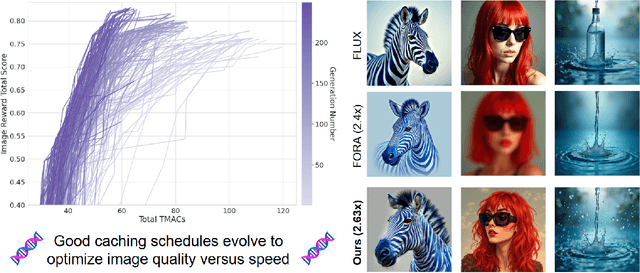

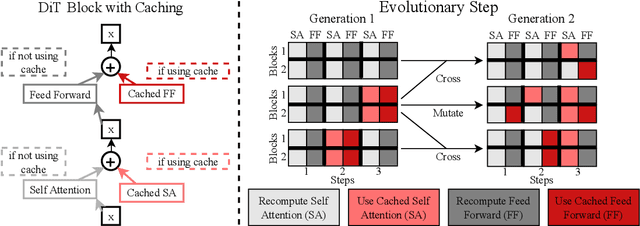
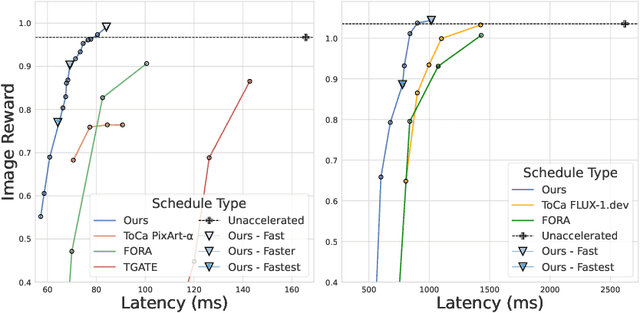
Abstract:Diffusion-based image generation models excel at producing high-quality synthetic content, but suffer from slow and computationally expensive inference. Prior work has attempted to mitigate this by caching and reusing features within diffusion transformers across inference steps. These methods, however, often rely on rigid heuristics that result in limited acceleration or poor generalization across architectures. We propose Evolutionary Caching to Accelerate Diffusion models (ECAD), a genetic algorithm that learns efficient, per-model, caching schedules forming a Pareto frontier, using only a small set of calibration prompts. ECAD requires no modifications to network parameters or reference images. It offers significant inference speedups, enables fine-grained control over the quality-latency trade-off, and adapts seamlessly to different diffusion models. Notably, ECAD's learned schedules can generalize effectively to resolutions and model variants not seen during calibration. We evaluate ECAD on PixArt-alpha, PixArt-Sigma, and FLUX-1.dev using multiple metrics (FID, CLIP, Image Reward) across diverse benchmarks (COCO, MJHQ-30k, PartiPrompts), demonstrating consistent improvements over previous approaches. On PixArt-alpha, ECAD identifies a schedule that outperforms the previous state-of-the-art method by 4.47 COCO FID while increasing inference speedup from 2.35x to 2.58x. Our results establish ECAD as a scalable and generalizable approach for accelerating diffusion inference. Our project website is available at https://aniaggarwal.github.io/ecad and our code is available at https://github.com/aniaggarwal/ecad.
Imagine, Verify, Execute: Memory-Guided Agentic Exploration with Vision-Language Models
May 12, 2025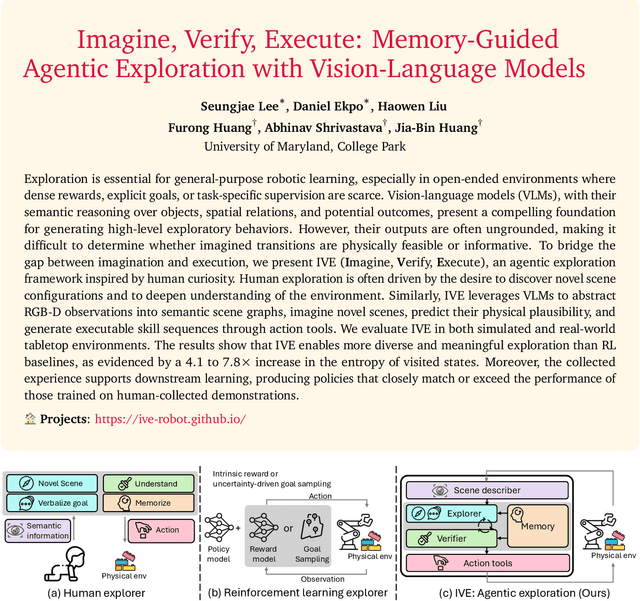

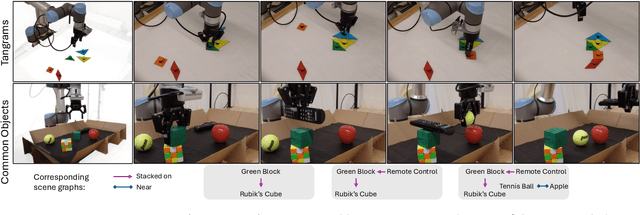

Abstract:Exploration is essential for general-purpose robotic learning, especially in open-ended environments where dense rewards, explicit goals, or task-specific supervision are scarce. Vision-language models (VLMs), with their semantic reasoning over objects, spatial relations, and potential outcomes, present a compelling foundation for generating high-level exploratory behaviors. However, their outputs are often ungrounded, making it difficult to determine whether imagined transitions are physically feasible or informative. To bridge the gap between imagination and execution, we present IVE (Imagine, Verify, Execute), an agentic exploration framework inspired by human curiosity. Human exploration is often driven by the desire to discover novel scene configurations and to deepen understanding of the environment. Similarly, IVE leverages VLMs to abstract RGB-D observations into semantic scene graphs, imagine novel scenes, predict their physical plausibility, and generate executable skill sequences through action tools. We evaluate IVE in both simulated and real-world tabletop environments. The results show that IVE enables more diverse and meaningful exploration than RL baselines, as evidenced by a 4.1 to 7.8x increase in the entropy of visited states. Moreover, the collected experience supports downstream learning, producing policies that closely match or exceed the performance of those trained on human-collected demonstrations.
TREND: Tri-teaching for Robust Preference-based Reinforcement Learning with Demonstrations
May 09, 2025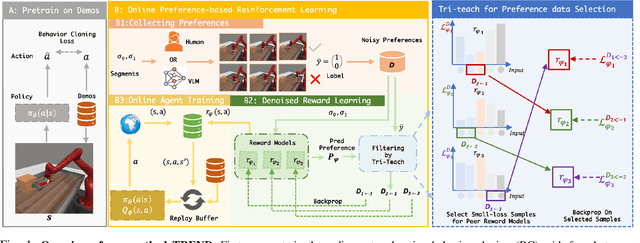
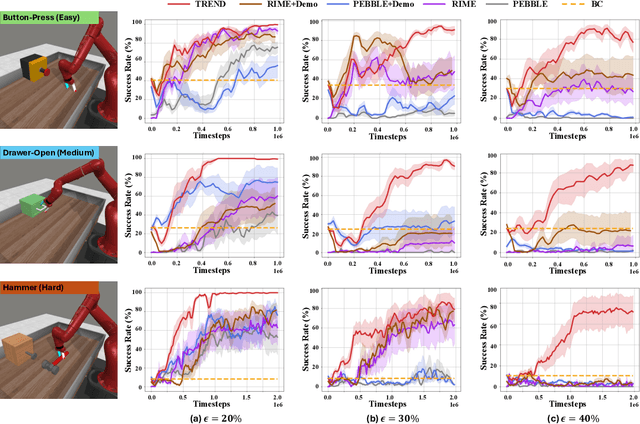
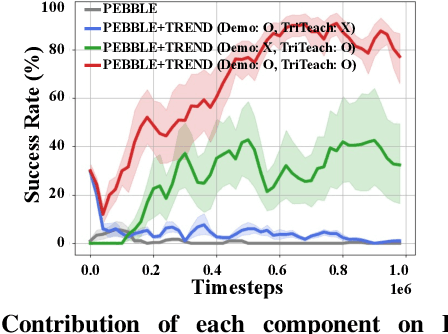
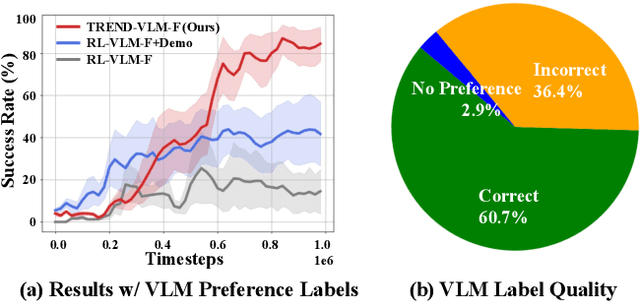
Abstract:Preference feedback collected by human or VLM annotators is often noisy, presenting a significant challenge for preference-based reinforcement learning that relies on accurate preference labels. To address this challenge, we propose TREND, a novel framework that integrates few-shot expert demonstrations with a tri-teaching strategy for effective noise mitigation. Our method trains three reward models simultaneously, where each model views its small-loss preference pairs as useful knowledge and teaches such useful pairs to its peer network for updating the parameters. Remarkably, our approach requires as few as one to three expert demonstrations to achieve high performance. We evaluate TREND on various robotic manipulation tasks, achieving up to 90% success rates even with noise levels as high as 40%, highlighting its effective robustness in handling noisy preference feedback. Project page: https://shuaiyihuang.github.io/publications/TREND.
CoLLM: A Large Language Model for Composed Image Retrieval
Mar 25, 2025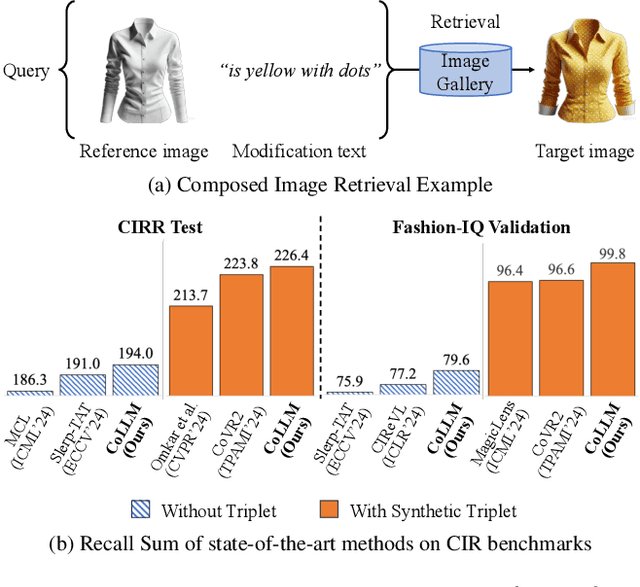
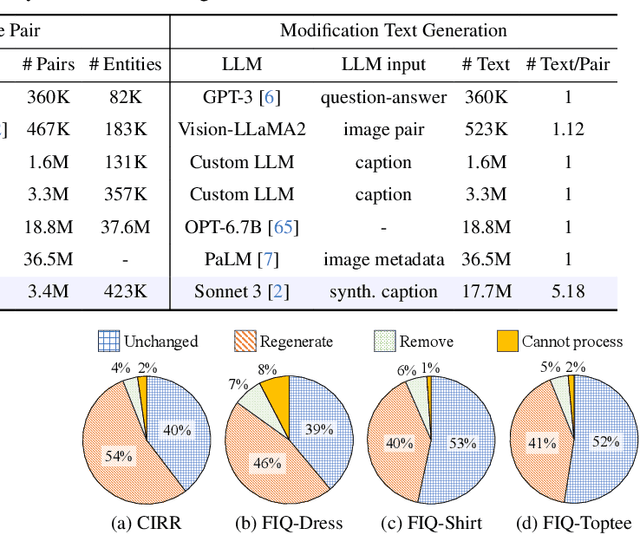
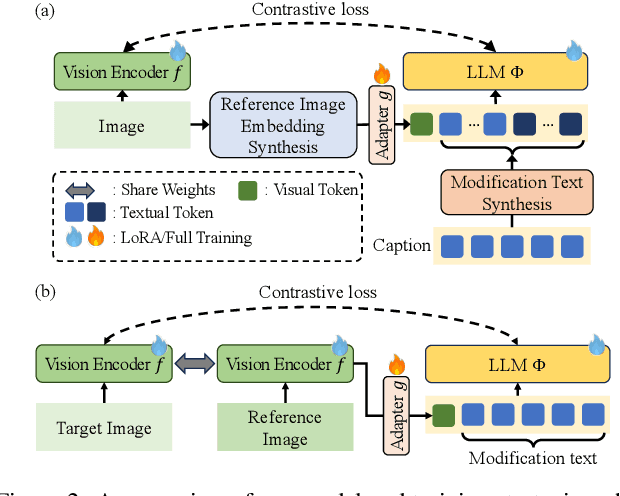
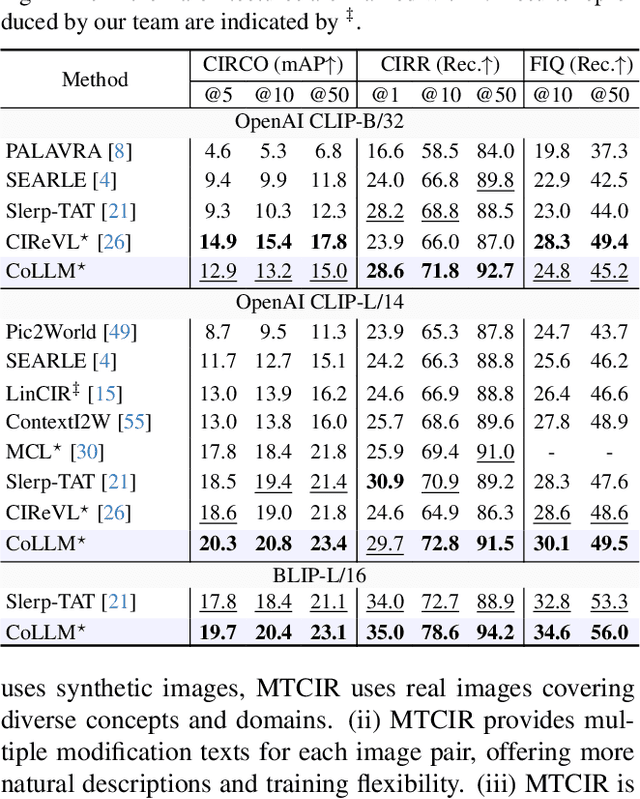
Abstract:Composed Image Retrieval (CIR) is a complex task that aims to retrieve images based on a multimodal query. Typical training data consists of triplets containing a reference image, a textual description of desired modifications, and the target image, which are expensive and time-consuming to acquire. The scarcity of CIR datasets has led to zero-shot approaches utilizing synthetic triplets or leveraging vision-language models (VLMs) with ubiquitous web-crawled image-caption pairs. However, these methods have significant limitations: synthetic triplets suffer from limited scale, lack of diversity, and unnatural modification text, while image-caption pairs hinder joint embedding learning of the multimodal query due to the absence of triplet data. Moreover, existing approaches struggle with complex and nuanced modification texts that demand sophisticated fusion and understanding of vision and language modalities. We present CoLLM, a one-stop framework that effectively addresses these limitations. Our approach generates triplets on-the-fly from image-caption pairs, enabling supervised training without manual annotation. We leverage Large Language Models (LLMs) to generate joint embeddings of reference images and modification texts, facilitating deeper multimodal fusion. Additionally, we introduce Multi-Text CIR (MTCIR), a large-scale dataset comprising 3.4M samples, and refine existing CIR benchmarks (CIRR and Fashion-IQ) to enhance evaluation reliability. Experimental results demonstrate that CoLLM achieves state-of-the-art performance across multiple CIR benchmarks and settings. MTCIR yields competitive results, with up to 15% performance improvement. Our refined benchmarks provide more reliable evaluation metrics for CIR models, contributing to the advancement of this important field.
Utilization of Neighbor Information for Image Classification with Different Levels of Supervision
Mar 18, 2025Abstract:We propose to bridge the gap between semi-supervised and unsupervised image recognition with a flexible method that performs well for both generalized category discovery (GCD) and image clustering. Despite the overlap in motivation between these tasks, the methods themselves are restricted to a single task -- GCD methods are reliant on the labeled portion of the data, and deep image clustering methods have no built-in way to leverage the labels efficiently. We connect the two regimes with an innovative approach that Utilizes Neighbor Information for Classification (UNIC) both in the unsupervised (clustering) and semisupervised (GCD) setting. State-of-the-art clustering methods already rely heavily on nearest neighbors. We improve on their results substantially in two parts, first with a sampling and cleaning strategy where we identify accurate positive and negative neighbors, and secondly by finetuning the backbone with clustering losses computed by sampling both types of neighbors. We then adapt this pipeline to GCD by utilizing the labelled images as ground truth neighbors. Our method yields state-of-the-art results for both clustering (+3% ImageNet-100, Imagenet200) and GCD (+0.8% ImageNet-100, +5% CUB, +2% SCars, +4% Aircraft).
Mitigating Hallucinations in Diffusion Models through Adaptive Attention Modulation
Feb 24, 2025



Abstract:Diffusion models, while increasingly adept at generating realistic images, are notably hindered by hallucinations -- unrealistic or incorrect features inconsistent with the trained data distribution. In this work, we propose Adaptive Attention Modulation (AAM), a novel approach to mitigate hallucinations by analyzing and modulating the self-attention mechanism in diffusion models. We hypothesize that self-attention during early denoising steps may inadvertently amplify or suppress features, contributing to hallucinations. To counter this, AAM introduces a temperature scaling mechanism within the softmax operation of the self-attention layers, dynamically modulating the attention distribution during inference. Additionally, AAM employs a masked perturbation technique to disrupt early-stage noise that may otherwise propagate into later stages as hallucinations. Extensive experiments demonstrate that AAM effectively reduces hallucinatory artifacts, enhancing both the fidelity and reliability of generated images. For instance, the proposed approach improves the FID score by 20.8% and reduces the percentage of hallucinated images by 12.9% (in absolute terms) on the Hands dataset.
Video Decomposition Prior: A Methodology to Decompose Videos into Layers
Dec 09, 2024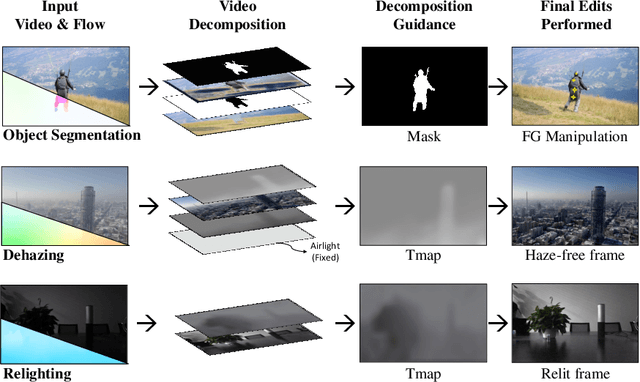

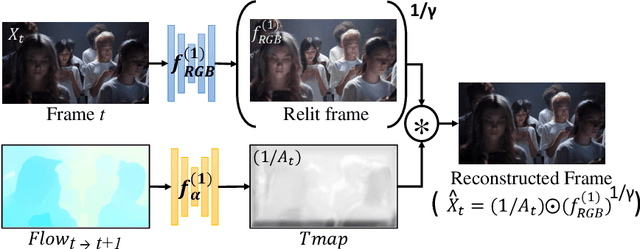
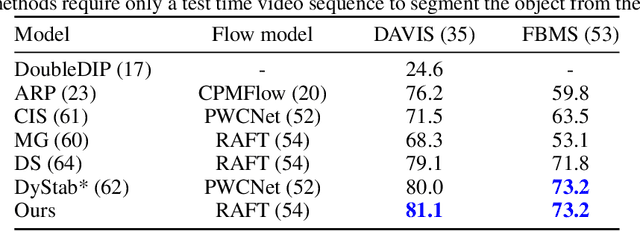
Abstract:In the evolving landscape of video enhancement and editing methodologies, a majority of deep learning techniques often rely on extensive datasets of observed input and ground truth sequence pairs for optimal performance. Such reliance often falters when acquiring data becomes challenging, especially in tasks like video dehazing and relighting, where replicating identical motions and camera angles in both corrupted and ground truth sequences is complicated. Moreover, these conventional methodologies perform best when the test distribution closely mirrors the training distribution. Recognizing these challenges, this paper introduces a novel video decomposition prior `VDP' framework which derives inspiration from professional video editing practices. Our methodology does not mandate task-specific external data corpus collection, instead pivots to utilizing the motion and appearance of the input video. VDP framework decomposes a video sequence into a set of multiple RGB layers and associated opacity levels. These set of layers are then manipulated individually to obtain the desired results. We addresses tasks such as video object segmentation, dehazing, and relighting. Moreover, we introduce a novel logarithmic video decomposition formulation for video relighting tasks, setting a new benchmark over the existing methodologies. We observe the property of relighting emerge as we optimize for our novel relighting decomposition formulation. We evaluate our approach on standard video datasets like DAVIS, REVIDE, & SDSD and show qualitative results on a diverse array of internet videos. Project Page - https://www.cs.umd.edu/~gauravsh/video_decomposition/index.html for video results.
Continuous Video Process: Modeling Videos as Continuous Multi-Dimensional Processes for Video Prediction
Dec 09, 2024



Abstract:Diffusion models have made significant strides in image generation, mastering tasks such as unconditional image synthesis, text-image translation, and image-to-image conversions. However, their capability falls short in the realm of video prediction, mainly because they treat videos as a collection of independent images, relying on external constraints such as temporal attention mechanisms to enforce temporal coherence. In our paper, we introduce a novel model class, that treats video as a continuous multi-dimensional process rather than a series of discrete frames. We also report a reduction of 75\% sampling steps required to sample a new frame thus making our framework more efficient during the inference time. Through extensive experimentation, we establish state-of-the-art performance in video prediction, validated on benchmark datasets including KTH, BAIR, Human3.6M, and UCF101. Navigate to the project page https://www.cs.umd.edu/~gauravsh/cvp/supp/website.html for video results.
 Add to Chrome
Add to Chrome Add to Firefox
Add to Firefox Add to Edge
Add to Edge